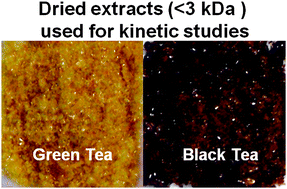Inhibition of angiotensin converting enzyme (ACE) activity by polyphenols from tea (Camellia sinensis) and links to processing method
Abstract
The focus of this study was to investigate

* Corresponding authors
a
CSIRO Preventative Health Flagship, CSIRO Food and Nutritional Sciences, 671 Sneydes Road, Private Bag 16, Werribee, Victoria, Australia
Fax: +61 3 9731 3390
Tel: +61 3 9731 3200
b Zhejiang University, Tea Research Institute, 268 Kaixuan Road, Hangzhou, PR China
c CSIRO Preventative Health National Research Flagship, PO Box 10041, Adelaide, BC, SA, Australia
The focus of this study was to investigate

 Please wait while we load your content...
Something went wrong. Try again?
Please wait while we load your content...
Something went wrong. Try again?
J. Dong, X. Xu, Y. Liang, R. Head and L. Bennett, Food Funct., 2011, 2, 310 DOI: 10.1039/C1FO10023H
To request permission to reproduce material from this article, please go to the Copyright Clearance Center request page.
If you are an author contributing to an RSC publication, you do not need to request permission provided correct acknowledgement is given.
If you are the author of this article, you do not need to request permission to reproduce figures and diagrams provided correct acknowledgement is given. If you want to reproduce the whole article in a third-party publication (excluding your thesis/dissertation for which permission is not required) please go to the Copyright Clearance Center request page.
Read more about how to correctly acknowledge RSC content.
 Fetching data from CrossRef.
Fetching data from CrossRef.
This may take some time to load.
Loading related content
